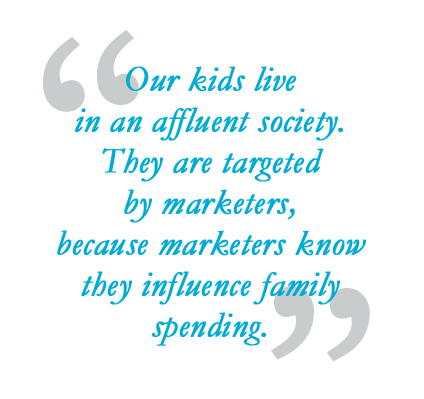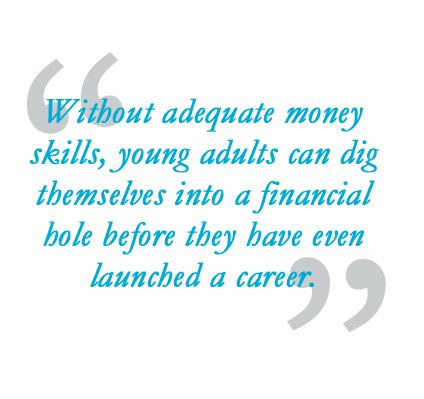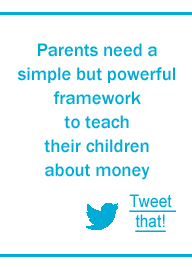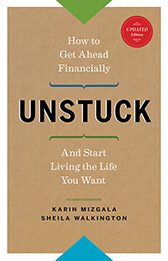By Kathryn Mandelcorn, FMA

How we feel about money, and how we manage it, has a lot to do with what our parents did or did not do. We carry our money beliefs, positive and negative, from our childhood straight into adulthood and they affect our relationships and our earning potential.
As parents, part of acknowledging the impact of our childhood experiences on our adult money habits; is reflecting on what we are teaching our own children. Are we passing on the best of what we know? Are we even aware of the messages we are sending?
Childhood in 2016 is a very different world
Children born in the 21st century live in a world that is incredibly different than the one we grew up in. They are bombarded by advertising, though channels that didn’t even exist in our childhoods.
Can you even imagine having owned something as expensive as a smart phone when you were nine years old? Our kids live in an affluent society. They are targeted by marketers, because marketers know they influence family spending. It’s no wonder that lots of  perfectly nice kids have a case of the wants. Many of us want to give them what they want, because we’ve worked hard and we can. But every time we give our kids something because of how it makes us feel about ourselves and our success, we are running the risk of setting our kids up for financial failure in the future. Our job, our responsibility, is to help them learn to manage and understand money.
perfectly nice kids have a case of the wants. Many of us want to give them what they want, because we’ve worked hard and we can. But every time we give our kids something because of how it makes us feel about ourselves and our success, we are running the risk of setting our kids up for financial failure in the future. Our job, our responsibility, is to help them learn to manage and understand money.
When we were kids, most of us saw our parents using cash at movies and restaurants and grocery stores. How often do you use cash? Children in 2016 may get a cash allowance (they should, and we’ll talk about that more in a minute) but how often do they see adults use cash? We tap for coffee at the drive through window, we buy things from our phone, we hand over debit or credit cards (which look the same to a child), not only at the mall and grocery store, but even to the pizza delivery person at the front door. How can children understand the idea, we can’t afford that, when all they have seen are goods exchanged for the swipe of a plastic card.
A greater urgency to educate
Money is becoming “invisible” and it’s difficult to teach children the value of something they don’t see. But if we don’t teach our kids about money they will pay a high price in years to come. Spending money has never been so simple — or so easily mindless. For example, kids (and adults) playing the popular game Candy Crush have the opportunity to  make in-app purchases for extra moves and candy boosters to improve the odds of moving through the levels. These in-app purchases range from $1.39 to over $100.00! But it doesn’t look as if you are really spending money, you just see cartoon gold bars; actual cash never makes an appearance in the transaction.
make in-app purchases for extra moves and candy boosters to improve the odds of moving through the levels. These in-app purchases range from $1.39 to over $100.00! But it doesn’t look as if you are really spending money, you just see cartoon gold bars; actual cash never makes an appearance in the transaction.
The result of all this quick and easy spending is that kids often grow up without a real appreciation for the value of a dollar. At 18 years-old, it’s relatively easy to qualify for a credit card, and without adequate money skills, these young adults can dig themselves into a financial hole before they have even launched a career.
A simple but powerful framework to teach our children about money
Author and speaker Nancy Phillips has written many books and created several products to teach financial literacy to children. She believes it’s essential that we begin teaching financial skills as early as possible and that we do so by giving our children an allowance in cash.
She developed the GISS method of teaching financial skills when her children were young. GISS stands for Give, Invest, Save, Spend. The idea is that kids create a bank with four compartments (she recommends four miniature cereal boxes stacked and decorated, but four jars or four envelopes would work too). Each compartment is labelled with one of the GISS words and each time you give your kids their allowance they divide it into the compartments.
Simple? Yes. And very powerful. Powerful because it sets a value system in motion that will grow with the child. Let’s look at each category more closely.
Give
Phillips believes that we start with Give to teach our kids that they can and should give to others. Money they earn can be used to support people and causes that are important to them. Having your children decide where they will give their money is an important part of the process. It helps them reflect on what matters to them and makes them aware that money is a way to contribute to their community. Having them volunteer in some way, when it is age appropriate, will also reinforce their connection to their values. When giving is taught young, it creates adults that are more aware of their capacity to positively impact the world.
Invest
Investing teaches kids that they need to think beyond their immediate wants and needs and plan for the future. This can be harder for younger children to grasp, but they will come to understand it gradually. At first the money can remain in its GISS bank compartment, but as the kids get older they can be taught about savings bonds and other ways to grow their money. You can even talk to them about your own investments and retirement planning. An important lesson from this category is how small amounts add up to big savings over time. Creating the investment habit at a young age means that as adults they will naturally look for ways to invest and build net worth.
Save
The Save category is critical. I mentioned earlier how kids are bombarded by opportunities to spend. We need to offer them opportunities to save. Saving means they learn to delay gratification, and it means that they have to choose what to save for. Even if they decide to save for multiple items (Phillips recommends having a wish list) they are learning how to set priorities, and to think about how much they really want something. Not only does this help them develop the discipline to save that will serve them throughout their life, it also helps with goal achievement skills in general.
Spend
The money in the spend compartment is for your children to spend as they wish. It may be frustrating to watch them make a wrong choice from time to time, and they may end-up with some tears if something they buy doesn’t live up to expectations, but making mistakes when the stakes are so low is just what is needed to create adults that value their money.
 The key to the whole system is cash. It’s so important that children have a tangible connection with money, so they can see it increase and decrease based on their actions. Having the GISS system in place also helps when your children run into temptation at the mall. When they want something you can ask them if they have enough money in their spending account. And, if they don’t, you can ask if it’s something they want to save for. If they are already saving for something else, they can weigh this new temptation against their current goal. Making financial decisions as children will lead to feeling empowered around money as an adult.
The key to the whole system is cash. It’s so important that children have a tangible connection with money, so they can see it increase and decrease based on their actions. Having the GISS system in place also helps when your children run into temptation at the mall. When they want something you can ask them if they have enough money in their spending account. And, if they don’t, you can ask if it’s something they want to save for. If they are already saving for something else, they can weigh this new temptation against their current goal. Making financial decisions as children will lead to feeling empowered around money as an adult.
So how do you divide the money? This can be something you decide with your children, but Nancy Phillips recommends: Give 10%, Invest 15%, Save 25% and Spend 50%.
The earlier you start your child’s financial education the better, because good habits will be all that they know. But if your kids are older, you can still start the GISS conversation and get them excited about a savings goal or helping a charity. It’s never too late to create or improve money habits. In fact, creating a habit of spending awareness is something you may wish to join in with your children. If it’s been a long time since you have used cash, try it out for a month or two, and see if it impacts your spending habits. You’ll also send a positive message about mindful spending to your children. Children don’t always listen to what we say, but they are always learning from what we do.


